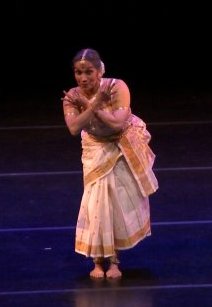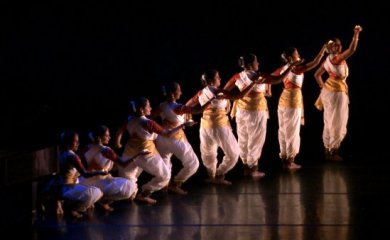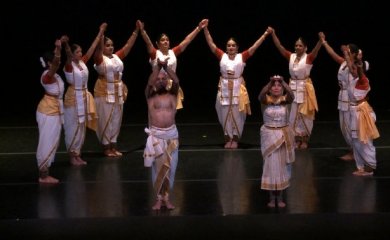
|   |

|   |
A moment in time - Anita Vallabh e-mail: aniaeka@gmail.com November 30, 2014 I write my point of view of the performance on November 8th in Washington DC under the aegis of Dakshina / Daniel Phoenix Singh Dance Company’s 11th annual fall festival of dance and music. This is not an attempt to praise or to please. It is only about the Bharatanatyam performance, for I have little theoretical knowledge of music to critique. Did the mellifluous voice of Sikkil Gurucharan and his soulful rendition blend with the impressive dexterity of Anil Srinivasan’s nimble fingers on the piano to pitch perfection? Soulful music, subdued lighting, the dance and the dancers came together to weave a reverential motif to ‘Jyotirgamaya: Light on the Path.’ The program opened with two presentations by Dakshina’s ensemble dancers, Panchaksharam in Ragamalika choreographed by Sheejith Krishna, and Shivoham in ragam Charukesi, choreographed by Rama Vaidyanathan. A poetical exposition of Saivite philosophy, the Panchakshara stotram of Adi Shankaracharya was very well rehearsed and performed with precision by the dancers. I had previously seen Sheejith Krishna’s choreographic brilliance in the Masquerade and Kalabhairava ashtakam. Panchakshara stotram too had his choreographic insignia where elements of movement/mimesis, active/passive, and absence/presence are subtly suggested to create a profound experience. The only unwarranted distraction was the inclusion of Nandi chol. An otherwise beautiful composition, the Nandi chol had no place in the composition and seemed to have been included as an afterthought. Shivoham has been my personal favorite ever since I saw Rama Vaidyanathan perform to the song in Chennai a few years ago. The music was divine and so was the choreography when I saw her perform solo. As a group, although the dancer’s hard work and involvement came through, the choreography itself didn’t seem inspired. Also I think this composition is best performed towards the end of a margam when joyous exertion sensitizes the dancer to stillness and a curious excitement, culminating in a dynamic yet subdued composition like Shivoham with its lilting refrain ‘Jeevaha shivaha shivo jeevaha.’ Both the compositions were earnestly executed by the dancers Nithya Joseph, Valli Sanmugalingam, Medha Swaminathan, and Sudha Radha Krishnan. In shades of white and gold, and play of light and shadow the second half of the performance commenced with a recital by the Dhananjayans. To me, they are ‘sir’ and ‘akka’. At the heart of Sir’s craft is this simple truth – if we observe nature and infuse the knowledge of our everyday experiences into the creative process, the power in our dance narrative becomes a valuable acknowledgement of our reality. This is best exemplified in the simplicity of his rendition of Gopalakrishna Bharati’s “Enneramum” in Devagandhari ragam. This expressive narrative, at a deeper level reveals glimpses of the divine revelations he has experienced in his life with moments of creative brilliance. Through these ‘moments’ he has given birth to many deeply moving compositions that he expresses in the most powerful way. “Enneramum” is one of many. There is not a moment of hyperbole, unnecessary mannerism or superficial, dishonest display of emotion. There is only an unhurried simplicity, spontaneity and wisdom to just ‘be in the moment.’ 



Shanta Dhananjayan’s depiction of a vasakasajja nayika in “Theruvil varano” was everything you would expect from a legend - practiced precision with every emotion portrayed with restraint, expected out of an uttama nayika. If natyam is thought of as a barometer of who we truly are, then akka’s performances is everything she is in her personal and professional life; lucid, purposeful, eliminating the superfluous so that the essence speaks, leaving no room for criticism. However, at this point it would do us students justice to see teachers of great standing explore the nayikas and present the compositions from different perspectives. Amongst the 384 different classifications of the nayikas based on their social standing, and psychological conditions (numbered, classified and defined by my guru and guide, Dr. Pappu Venugopal Rao), the scope for an intellectually stimulating abhinaya can extend beyond the ordinary. For example, the vasakasajja nayika of “Theruvil varano” is presented as a sweeya-praudha nayika. It would make for an interesting choreography to present the nayika as a mugdha (visrabdha navodha – shy and excited) or a paraakiya. These implicit variations in presentation I believe will articulate a sensibility that engages pre-modern literature to post modern everyday experiences that are significant to our lives. Anita Vallabh is an adjunct professor in the Department of Theatre and Dance at the University of Hawaii. She is the author of ‘Message in Movements’ - an illustrated translation of Abhinaya Darpanam. She is a disciple of The Dhananjayans and Dr. Pappu Venugopala Rao. |